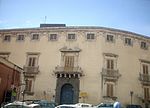Church of the Oratory, Acireale
The Church of the Oratory or in Italian, Chiesa dell’Oratorio or Chiesa dei Padri Filippini is a Neoclassical-style Roman Catholic church located on Via San Rafaele #1 in Acireale, region of Sicily, Italy. The church is notable for artworks by Antonino Bonaccorsi, Paolo Leonardi Vigo, Francesco Mancini, and Alessandro Vasta. The church is still affiliated with the order which runs the nearby Istituto San Michele.The Oratorians did not arrive to Acireale until 1827, when they were invited by the bishop. This church was not completed until 1840. The altarpieces commissioned for the church, include: Phillip Neri brings children to a statue of Christ with Baronius in background by Bonaccorsi Aloysius Gonzaga receives the first communion from Carlo Borromeo by Leonardi Holy Family by Mancini Madonna of the Puberty by Alessandro Vasta Ceiling fresco of Phillip Neri by Giuseppe Rapisardi
Excerpt from the Wikipedia article Church of the Oratory, Acireale (License: CC BY-SA 3.0, Authors).Church of the Oratory, Acireale
Via Angelo Raffaele,
Geographical coordinates (GPS) Address Nearby Places Show on map
Geographical coordinates (GPS)
| Latitude | Longitude |
|---|---|
| N 37.61159 ° | E 15.16692 ° |
Address
chiesa dei Filippini
Via Angelo Raffaele
95024
Sicily, Italy
Open on Google Maps








